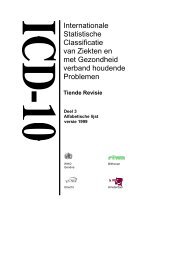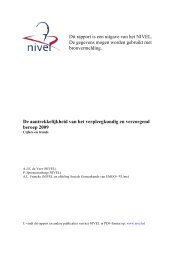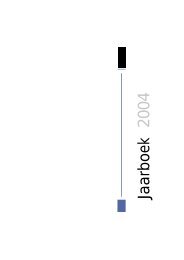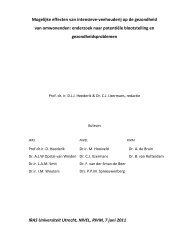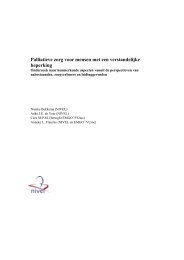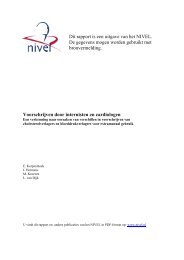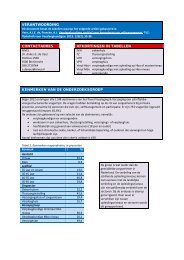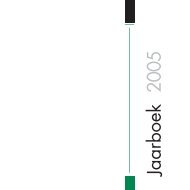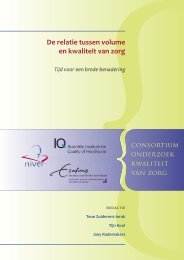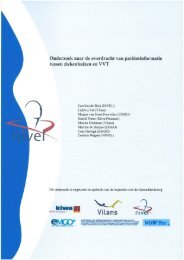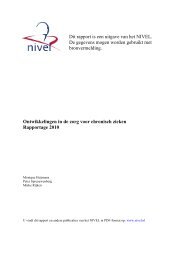Multi-Sensory Stimulation in 24-hour Dementia Care - Nivel
Multi-Sensory Stimulation in 24-hour Dementia Care - Nivel
Multi-Sensory Stimulation in 24-hour Dementia Care - Nivel
You also want an ePaper? Increase the reach of your titles
YUMPU automatically turns print PDFs into web optimized ePapers that Google loves.
The fifth objective was to f<strong>in</strong>d out whether the implementation of snoezelen had a<br />
positive effect on the quality of work<strong>in</strong>g life of CNAs who apply snoezel care,<br />
compared to CNAs who apply usual care.<br />
In particular, it was hypothesized that the <strong>in</strong>tervention would lead to measurable,<br />
positive changes <strong>in</strong><br />
Workload: the activities that someone has to carry out <strong>in</strong> a particular<br />
environment, classified <strong>in</strong> job characteristics (skill variety, learn<strong>in</strong>g opportunities,<br />
autonomy, hav<strong>in</strong>g a say) and work<strong>in</strong>g conditions (time pressure, role ambiguity).<br />
Positive effects of the implementation of<br />
snoezelen were especially assumed on work<strong>in</strong>g conditions.<br />
Psychological outcomes of CNAs : the subjective experience of the actual<br />
workload, operationalised <strong>in</strong> perceived problems, stress reactions, job satisfaction<br />
and burnout.<br />
Design of the study<br />
A quasi-experimental pre-test and post-test design was carried out. The study was<br />
performed <strong>in</strong> twelve psycho-geriatric wards of six Dutch nurs<strong>in</strong>g homes. The six<br />
experimental wards received a tra<strong>in</strong><strong>in</strong>g ‘snoezelen for caregivers’ to implement<br />
snoezelen <strong>in</strong> <strong>24</strong>-h care. In the six control wards, usual care was cont<strong>in</strong>ued.<br />
Randomisation took place at ward level by way of an <strong>in</strong>dependent person draw<strong>in</strong>g<br />
lots drawn from a sealed conta<strong>in</strong>er. Nurs<strong>in</strong>g units were randomised with<strong>in</strong> each<br />
nurs<strong>in</strong>g home (every nurs<strong>in</strong>g home delivered an experimental and a control ward)<br />
<strong>in</strong>stead of randomis<strong>in</strong>g entire nurs<strong>in</strong>g homes. Therefore, the experimental and the<br />
control group were considered to be comparable <strong>in</strong> terms of admission policy,<br />
capacity for psychogeriatric residents, population of psychogeriatric residents on the<br />
ward, composition of nurs<strong>in</strong>g staff, staff-client ratio, used care model at basel<strong>in</strong>e,<br />
system of resident-allocation, service types and degree of care <strong>in</strong>novation. By<br />
<strong>in</strong>terviews with staff members, these aspects were verified. In case of allocation to<br />
the control group, the ward had to refra<strong>in</strong> from snoezelen tra<strong>in</strong><strong>in</strong>g or implementation<br />
of elements from the snoezel care model dur<strong>in</strong>g the study period. Commitment to this<br />
and other <strong>in</strong>clusion criteria (see chapter 6) were laid down <strong>in</strong> a co-operative<br />
agreement. Control for contam<strong>in</strong>ation on the control wards was done by<br />
<strong>in</strong>terview<strong>in</strong>g the head nurses. Control on the <strong>in</strong>tervention <strong>in</strong> the experimental wards<br />
was done by participat<strong>in</strong>g observations <strong>in</strong> five of the six experimental wards (Janssen,<br />
2001; Vrugg<strong>in</strong>k, 2004).<br />
Measurements were performed at basel<strong>in</strong>e and after 18 months <strong>in</strong> the period<br />
between January 2001 and February 2003. The nurs<strong>in</strong>g homes were consecutively<br />
<strong>in</strong>cluded between January (home 1) and August 2001 (home 6), <strong>in</strong> order to spread<br />
the activities with regard to the pre-test and post-test and the <strong>in</strong>tervention. The<br />
Introduction 21



